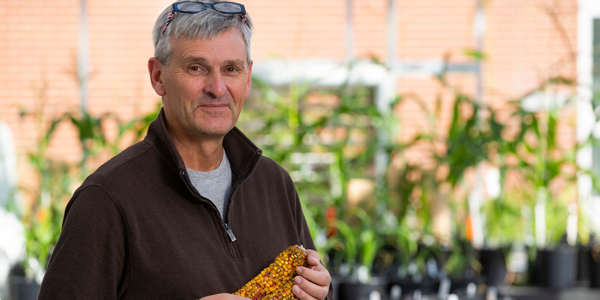
Advancing Plant Breeding Through Innovation, Collaboration
Thomas Lübberstedt is pushing the boundaries of genetics and its use in developing tools and methods to make plant breeding more efficient.
His work is leading to improved virus resistance and more sustainable agricultural systems around the world. The Frey Chair in Agronomy and Director of the Raymond F. Baker Center for Plant Breeding, Lübberstedt recently received the College of Agriculture and Life Sciences’ Outstanding Achievement in Research Award.
International Credentials
Lübberstedt grew up on a horticultural farm in Germany and earned his degrees from the universities of Munich and Hohenheim. He spent several years working in Germany, and then Denmark, before coming to Iowa State in 2007 to take an endowed chair position.
Since arriving, he has helped isolate two important virus-resistance genes for corn — work that has involved collaborations in China and in Africa that can improve resistance to the emerging threat of Maize Lethal Necrosis Disease in East Africa, an effort supported by the U.S. Agency for International Development. Lübberstedt is quietly passionate about his work combining plant breeding and molecular genetics.
“This is one of the most exciting scientific areas to be in, because of the tremendous progress in plant genomic research over the past decades and its impact on plant breeding,” he says. “This will remain a key area to address major societal challenges in the decades ahead.”
Advancing Doubled Haploid Research
Much of Lübberstedt’s research has been to improve technology for doubled haploids (DH), and he is known for establishing the first public doubled haploid facility in the United States. This work builds on research by another well-known Iowa State plant breeder, Sherret Chase. Chase, an agronomy professor in the 1940s and 1950s, was the first to exploit a natural genetic anomaly in corn he termed “doubled haploidism.”
DH technology allows creation of inbred lines that carry only a single, maternal genome. Through several steps, doubled haploids can be used to accelerate development of pure
genetic lines for research and plant breeding. However, as Chase discovered, the trait only happens in a small fraction of plants. Ever since, other scientists, including Thomas Lübberstedt, have been seeking to improve the efficiency of producing doubled haploids.
Lübberstedt has recently identified germplasm with a higher rate of spontaneous haploid genome doubling. Backcrossing this germplasm into breeding lines can significantly increase doubled haploids via a process that avoids using a common tool, the toxic chemical colchicine.
“This was a lucky find,” says Lübberstedt. “There are still many steps to bring this into wider use, but it has a lot of potential benefits.”
One of the benefits of creating doubled haploids without the use of colchicine is to improve breeding systems for organically grown corn, a goal of a multi-partner U.S. Department of Agriculture Organic Research and Extension Initiative grant Lübberstedt is leading. Another goal of that research is to create a mechanism for organically grown corn to resist pollination by transgenic pollen floating in from conventional fields, a problem that may result in huge losses for organic farmers.
Lübberstedt also is one of the primary researchers on a $7.3 million USDA Specialty Crop Research Initiative grant with the University of Florida, where his role is to implement doubled haploid technology for sweet corn.
Collaborator and Teacher
USDA Research Geneticist Paul Scott (’86 biochemistry and biophysics) is a partner on the USDA organics grant. Scott says about his colleague: “Thomas is a creative thinker and a very organized manager. He’s also quite selfless.”
Scott’s comment reflects regard for Lübberstedt’s contributions expressed by colleagues who nominated him for the recent CALS research award. They outlined many achievements beyond a long list of publications and grants, including his dedication to teaching and mentorship of graduate students, postdocs and visiting scientists. They also emphasized his leadership to launch and direct a distance master’s program in plant breeding that has 50 graduates worldwide.
Candice Gardner (’75 bacteriology), research leader for the USDA North Central Plant Introduction Center in Ames, has worked with Lübberstedt on several projects, recently on the Germplasm Enhancement of Maize program. She first met Lübberstedt when he came to campus to interview.
“Thomas is an excellent collaborator,” she says. “He deserves a lot of credit for creating the doubled haploid center, which provides widespread access to genetic resources that otherwise would only be available to a few well-resourced seed companies. It’s a good example of his tendency to raise everyone up.”
Sherret Chase: A pioneer in corn breeding
Technologies that underpin modern corn breeding began decades ago at Iowa State University. One such technology – doubled haploid plants – are thanks to Sherret Chase, a member of the botany faculty from 1947-1954. Chase earned degrees from Yale and Cornell University, where he conducted research alongside future Nobel prize-winning botanist and geneticist Barbara McClintock.
He is best known for identifying “haploids” of maize — plants with a single set of chromosomes. This led Chase to pioneer early techniques to obtain “doubled haploid” lines to accelerate the rate of selection for desirable genetic characteristics. He left Iowa State to work as a geneticist for DeKalb Ag Research (later part of Monsanto), where he developed the first successful commercial corn hybrid using doubled haploids. Over time, he was recruited for a number of prestigious academic and industry positions.
Chase, who turned 101 this year, will be presented with the Iowa State University College of Agriculture and Life Sciences Award for Sustained Excellence at the Baker Plant Breeding Symposium in Ames, Iowa, on March 6, 2020.



